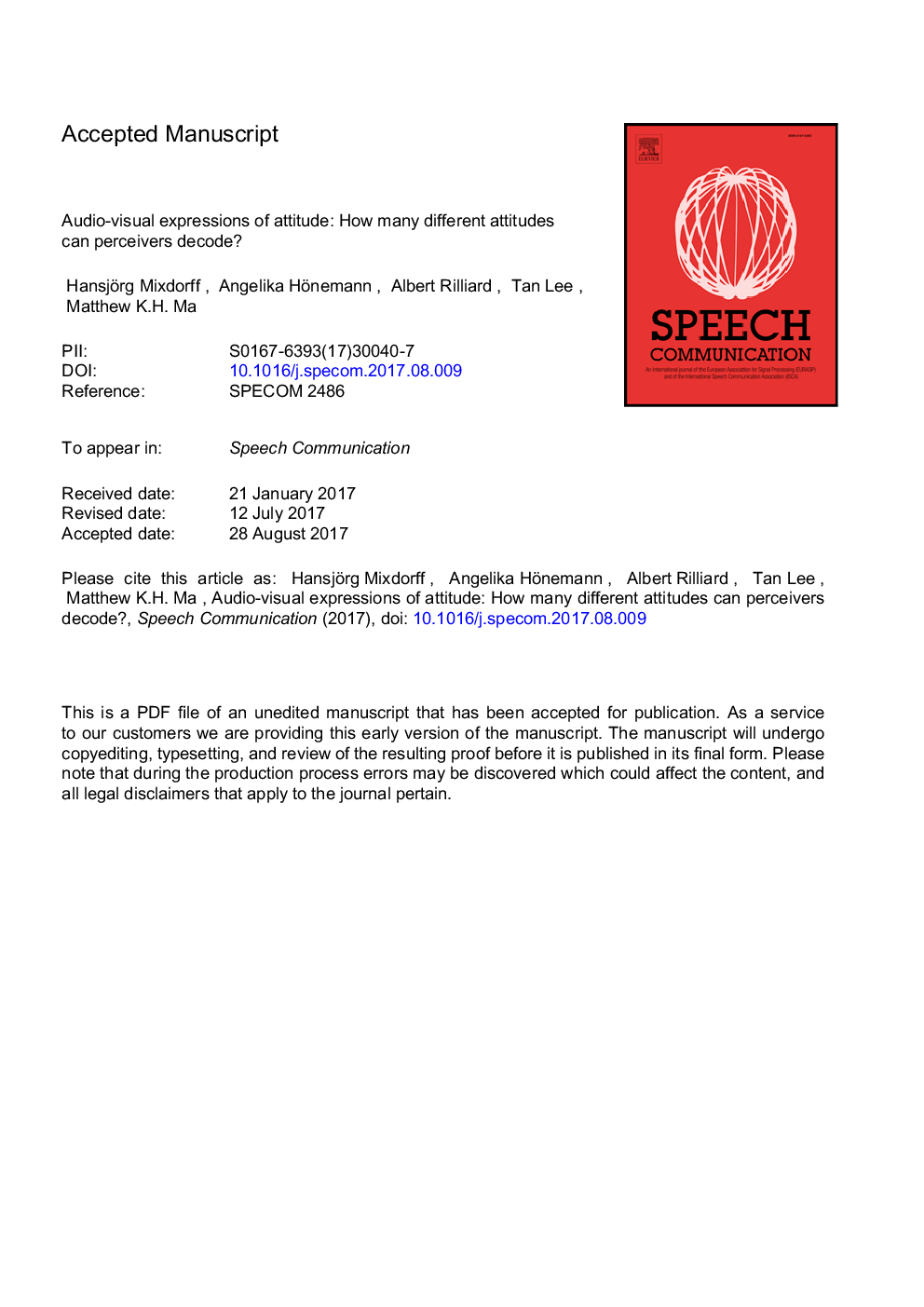| کد مقاله | کد نشریه | سال انتشار | مقاله انگلیسی | نسخه تمام متن |
|---|---|---|---|---|
| 6960890 | 1452005 | 2017 | 19 صفحه PDF | دانلود رایگان |
عنوان انگلیسی مقاله ISI
Audio-visual expressions of attitude: How many different attitudes can perceivers decode?
ترجمه فارسی عنوان
عبارات صوتی و تصویری نگرش: چگونه بسیاری از نگرش های مختلف می توانند تصور کننده تصور کنند؟
دانلود مقاله + سفارش ترجمه
دانلود مقاله ISI انگلیسی
رایگان برای ایرانیان
کلمات کلیدی
نگرش های اجتماعی، چند منظوره ادراک گفتاری، تولید سخنرانی، سخنرانی بیانگر تجزیه و تحلیل پروستودیک،
موضوعات مرتبط
مهندسی و علوم پایه
مهندسی کامپیوتر
پردازش سیگنال
چکیده انگلیسی
Based on the paradigm by Rilliard et al. we collected audio-visual expressions of attitudes such as arrogance, irony, sincerity and politeness in German. In the experimental design subjects are immersed in sixteen different communicative situations in which they are supposed to portray a certain attitude in a short dialog. Attitudes can be propositional, that is, reactions to a factual situation and/or social, that is, with respect to the relationship with the collocutor. Furthermore, attitudes can be of positive or negative valence or neutral. Undeniably there is a large repertory of subtle differences in the way certain talkers express certain attitudes. The important question is, however, whether collocutors either from the same language or a different one can actually decode these attitudes reliably. On that account we carried out three perceptual experiments in which we presented our recordings of the portrayed attitudes audio-visually, audio-only and video-only. In the first study, German perceivers rated the expressions given the intended attitude, in the second study, they had to choose the most suitable in a choice of five attitudes, and in the third study raters were able to assign freely the term best matching each attitudinal expression. This last experiment was recently replicated by native speakers of Cantonese in Hong Kong. The current article reviews and reevaluates the results from the first three experiments with the German subjects under the premise that perceivers actually have a more limited set of attitudinal registers which they can reliably draw on. This means that expressions can be sorted into a much smaller number of categories than the projected sixteen. In addition we compare and contrast these resulting clusters with the new data from the Cantonese speaking group. Our results indicate indeed a small number of readily decoded attitudes forming four clusters depending on the experiment design - which are also distinct acoustically. Clusters from the statistical analysis are very similar for the German and the Cantonese perceivers and overlap with basic emotions. This result suggests that expressions of attitudes with low identification rates are more complex to decode and require more pragmatic information, that is, more contextual and possibly idiosyncratic information to be interpreted correctly.
ناشر
Database: Elsevier - ScienceDirect (ساینس دایرکت)
Journal: Speech Communication - Volume 95, December 2017, Pages 114-126
Journal: Speech Communication - Volume 95, December 2017, Pages 114-126
نویسندگان
Hansjörg Mixdorff, Angelika Hönemann, Albert Rilliard, Tan Lee, Matthew K.H. Ma,
